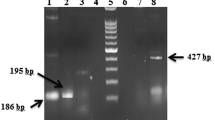Abstract
Entamoeba histolytica is known to cause intestinal and extra-intestinal disease while the other Entamoeba species are not considered to be pathogenic. However, all Entamoeba spp. should be reported when identified in clinical samples. Entamoeba polecki, Entamoeba coli, and Entamoeba hartmanii can be differentiated morphologically from E. histolytica, but some of their diagnostic morphologic features overlap. E. histolytica, Entamoeba dispar, and Entamoeba moshkovskii are morphologically identical but can be differentiated using molecular tools. We developed a polymerase chain reaction (PCR) procedure followed by DNA sequencing of specific regions of 18S rRNA gene to differentiate the Entamoeba spp. commonly found in human stools. This approach was used to analyze 45 samples from cases evaluated for the presence of Entamoeba spp. by microscopy and a real-time PCR method capable of differential detection of E. histolytica and E. dispar. Our results demonstrated an agreement of approximately 98% (45/44) between the real-time PCR for E. histolytica and E. dispar and the 18S rRNA analysis described here. Five previously negative samples by microscopy revealed the presence of E. dispar, E. hartmanii, or E. coli DNA. In addition, we were able to detect E. hartmanii in a stool sample that had been previously reported as negative for Entamoeba spp. by microscopy. Further microscopic evaluation of this sample revealed the presence of E. hartmanii cysts, which went undetected during the first microscopic evaluation. This PCR followed by DNA sequencing will be useful to refine the diagnostic detection of Entamoeba spp. in stool and other clinical specimens.

Similar content being viewed by others
References
Ali IB, Hossain MB, Roy S, Ayeh KPF, Petri WA, Haque R, Clark CG (2003) Entamoeba moshkovskii Infections in children in Bangladesh. Emerg Infect Dis 9:580–584
Ben AS, Ben AR, Mousli M, Aoun K, Thellier M, Bouratbine A (2008) Molecular differentiation of Entamoeba histolytica and Entamoeba dispar from Tunisian food handlers with infection initially diagnosed by microscopy. Parasite 15:65–68
Da Silva AJ, Bornay LJF, Moura IN, Slemenda SB, Tuttle JL, Pieniazek NJ (1999) Fast and reliable extraction of protozoan parasite DNA from fecal specimens. Mol Diagn 4:57–64
Dunbar SA (2006) Applications of Luminex xMAP technology for rapid, high-throughput multiplexed nucleic acid detection. Clin Chim Acta 363:71–82
Evangelopoulos A, Spanakos G, Patsoula E, Vakalis N (2000) A nested multiplex PCR assay for the simultaneous detection and differentiation of Entamoeba histolytica and Entamoeba dispar in faeces. Ann Trop Med Parasitol 94:233–240
Fotedar R, Stark D, Beebe N, Mariott D, Ellis J, Harkness J (2007) Laboratory diagnosis techniques for Entamoeba species. Clin Microbiol Rev 20:511–532
Garcia LS (2007) Intestinal protozoa: amebae. In: Garcia LS (ed) Diagnostic medical parasitology, 5th edn. ASM Press, Washington DC, pp 6–25
Gonin P, Trudel L (2003) Detection and differentiation of Entamoeba histolytica and Entamoeba dispar isolates in clinical samples by PCR and enzyme-linked immunosorbent assay. J Clin Microbiol 41:237–241
González RA, Haque R, Aquirre A, Castanón G, Hall A, Guhl F, Ruiz PG, Miles MA, Warhurst DC (1994) Value of microscopy in the diagnosis of dysentery associated with invasive Entamoeba histolytica. J Clin Pathol 47:236–239
Kebede A, Verweij JJ, Petros B, Polderman AM (2004) Misleading microscopy in amoebiasis. Trop Med Int Health 9:651–652
Mirelman D, Nuchamowitz Y, Stolarsky T (1997) Comparison of use enzyme-linked immunosorbent assay-based kits and PCR amplification of rRNA genes for simultaneous detection of Entamoeba histolytica and E. dispar. J Clin Microbiol 35:2405–2407
Petri WA, Haque R, Lyerly D, Vines RR (2000) Estimating the impact of amebiasis on health. Parasitol Today 16:320–321
Pritt BS, Clark CG (2008) Amebiasis. Mayo Clin Proc 83:1154–1160
Qvarnstrom Y, James C, Xayavong M, Holloway BP, Visvesvara GS, Sriram R, Da Silva AJ (2005) Comparison of real-time PCR protocols for diferential laboratory diagnosis of amebiasis. J Clin Microbiol 43:5491–5497
Rivera WL, Tachibana H, Kanbara H (1999) Application of the Polymerase Chain Reaction (PCR) in the epidemiology of Entamoeba histolytica and Entamoeba dispar. Tokai J Exp Clin Med 23:413–415
Santos HLC, Peralta RHS, Macedo HW, Bareto MGM, Peralta JM (2007) Comparison of multiplex-PCR and antigen detection for differential diagnosis of Entamoeba histolytica. Braz J Infect Dis 11:365–370
Tanyuksel M, Petri WA (2003) Laboratory diagnosis of amebiasis. Clin Microbiol Rev 16:713–729
Verweij JJ, Laeijendecker D, Brienen EA, Van LL, Polderman AM (2003a) Detection and identification of Entamoeba species in stool samples by a reverse line hybridization assay. J Clin Microbiol 41:5041–5045
Verweij JJ, Oostvogel F, Brienen EA, Nang BA, Ziem J, Polderman AM (2003b) Prevalence of Entamoeba histolytica and Entamoeba dispar in northern ghana. Trop Med Int Health 8:1153–1156
World Health Organization (1997). Amoebiasis. Report on the WHO/Pan American Health Organization/UNESCO Expert Consultation Mexico City Geneva-WHO W Epidemiol Rec 72:97–100.
Acknowledgments
The author thanks Dr. Edward da Silva for providing cultures of E. histolytica and E. moshkovskii. Helena L C Santos was supported by a fellowship from Conselho Nacional de Desenvolvimento Cientifico e Tecnológico (CNPq) programa/Brazil. This work was also supported with funds from the National Food Safety Initiative.
Author information
Authors and Affiliations
Corresponding author
Rights and permissions
About this article
Cite this article
Santos, H.L.C., Bandea, R., Martins, L.A.F. et al. Differential identification of Entamoeba spp. based on the analysis of 18S rRNA. Parasitol Res 106, 883–888 (2010). https://doi.org/10.1007/s00436-010-1728-y
Received:
Accepted:
Published:
Issue Date:
DOI: https://doi.org/10.1007/s00436-010-1728-y




